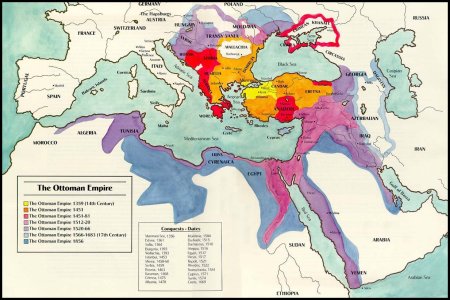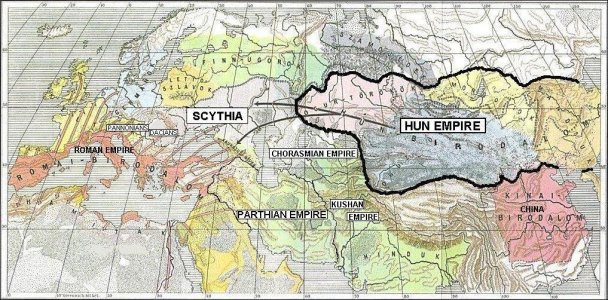Everyone keeps talking about odd ball civilizations. No offense but here are 17 different Turkish "civilizations", not a SINGLE one of them is in Civ3. A number of these empires were at the time one of the strongest most powerful in the world. Starting with Attila the Hun, Tamerlane, Sulieman the Magnificent. From China, through Central Asia, into the Middle East, Africa and Eastern Europe. That is some serious empire building... many people are talking about Spain and how powerful it was, Spain was a part of the Holy Roman Empire (consisting of present day Germany, Austria and more), under the rule of Charles V. There cheif rival of this mighty European Empire was Suleiman the Magnificent of the Ottoman Turks. Read any history book and it will tell you, the Turks were feared through out Europe, the only reason Christopher Columbus searched for new world was because they were looking for different routes to the East so they could avoid the taxes applied by the Turks, who had virtually turned the Mediteranean Sea into an Ottoman Lake.
Anyhow, I just looked at a poll, showed the Turks only at 6.9% - check the "MOST POPULAR VOTED CIV?" thread.... if you want the game to be more realistic from a historical point of view, then you have to have the key and major players of history in there, its as simple as that.
My picks once again and I REALLY hope you guys at Firaxis are listening: TURKS, ARABS, MONGOLS, ETHIOPIANS, KOREANS & JEWS...
In addition here are 17 different empires built by the Turks, check them out and you tell me, how you can overlook all of this, 17 different empires over history and yet they have no place in the game....
The 17 Great Turkish Empires
1) The "GREAT HUN EMPIRE" - 204 B.C - 216 A.D
Founder - Mete (Bagatir)
Area - At the north, Siberia; south, Tibet - Kashmir; east, Pacific Ocean; west, Caspian Sea; (Total Area - 18,000,000 Km 2)
2) The "WESTERN HUN EMPIRE" - 48 - 216 A.D
Founder - Panu
Area - The area over present Central Asia
3) The "EUROPEAN HUN EMPIRE" - 275 - 454 A.D
Founder - Muncuk, Oktar, Rua & Aybars (brothers)
Area - Southern Russia, Romania, Northern
Yugoslavia, Hungary, Austria, Chekoslovakia, Southern & Central Germany; The area from eastern France to the Ural mountains; from northern Hungary to the Byzantine Empire; (Total Area - 4,000,000 Km 2)
4) The "WHITE HUN EMPIRE" - 420 - 552 A.D
Founder - Aksuvar (Aksungur)
Area - Half of northern India,
Afghanistan, parts of Turkistan (Total Area - 3,500,000 Km 2)
5) The "GOKTURK EMPIRE" - 552 - 743 A.D
Founder - Bumin Khan (Tumen)
Area - The inacessible valleys of the Altay Mountains (Ergenikon) (Total Area - 18,000,000 Km 2)
6) The "AVAR EMPIRE" - 562 - 796 A.D
Founder - Bayar Khan
Area - The area between the Volga, Hungary and Bessarabia
7) "Khazar Empire" - 8th - 10th A.D
Extended from the northern shores of the Black Sea and the Caspian Sea to the Urals and as far westward as Kiev, including the Volga & Crimea.
8) The "HAZAR EMPIRE" - 602 - 1016 A.D
Founder - There are no historical data as to the original founder, however, its greatest ruler was Hakan Yusuf.
Area - The Hazars who are believed to be an offshoot of the Gokturks migrated to the West and formed a state stretching from the Caucasian Mntns to the Danube and to the middle of and Southern Russia.
9) The "UYGUR EMPIRE" - 740 - 1335 A.D
Founder - Kutlug Bilgekul Khan
Area - Central Asia and Northern Mongolia.
10) The "KARAHAN" - 932 - 1212 A.D
Founder - Saltuk Bugra Han
Area - All the Trans-Oxus area including the area between the Issyk and Balkash Lakes
11) The "GAZNELI EMPIRE" - 962 - 1183 A.D
Founder - Alptekin
Area - The area from the Trans-Oxus to the Ganges River, and from the shores of the Caspian to the steppes of the Pamir. (Total Area - 4,700,000 Km 2)
12) The "SELCUK EMPIRE" - 1040 - 1157 A.D
Founder - Seljuk
Area - At the East, Balkash and Issyk Lakes and the Tarim Derya; At the West, Aegean and the Mediterranean shores; At the North, Aral Lake, Caspian Sea, Caucasian and the Black Sea; At the South, the area including Arabia and the sea Omman. (Total Area - 10,000,000 Km 2)
13) The "HARZEMSHAH" - 1077 - 1231 A.D
Founder - Kudrettin Mehmet (Harzemshah)
Area - Persia, Southern Caucasia, Dagistan, Afghanistan and most of Central Asia. (Total Area - 5,000,000 Km 2)
14) The "GOLDEN HORDE" - 1224 - 1502 A.D
Founder - Batur Han
Area - Eastern Europe, the Western Ural Area, the Crimea and the area to the north of the Volga.
15) The "EMPIRE OF TIMUR KHAN" - 1369 - 1501 A.D
Founder - Timur Gurgani
Area - At the West, Balkans; At the North, Volga shores; At the South, Indian Ocean; At the East, Central Asia;
16) The "EMPIRE OF BABUR-MOGHULS" - 1526 - 1858 A.D
Founder - Babur Shah
Area - Afghanistan and India (Total Area - 2,700,000 Km 2)
17) The "OTTOMAN EMPIRE" - 1299 - 1922 A.D
Founder - Osman Bey
Area - Algeria, Tunisia, Libya, Egypt, Arabia, Jordan, Israel, Syria, Iraq, Anatolia, Caucasia, the Crimea, Bessarabia, Romania, Yugoslavia, Bulgaria, Greece, Cyprus, Hungary, the Sudan,.....and, the Black Sea, the Mediterranean Sea and the Red Sea were for a time - Turkish Lakes. (Total Area - 20,000,000 Km 2)
Anyhow, I just looked at a poll, showed the Turks only at 6.9% - check the "MOST POPULAR VOTED CIV?" thread.... if you want the game to be more realistic from a historical point of view, then you have to have the key and major players of history in there, its as simple as that.
My picks once again and I REALLY hope you guys at Firaxis are listening: TURKS, ARABS, MONGOLS, ETHIOPIANS, KOREANS & JEWS...
In addition here are 17 different empires built by the Turks, check them out and you tell me, how you can overlook all of this, 17 different empires over history and yet they have no place in the game....
The 17 Great Turkish Empires
1) The "GREAT HUN EMPIRE" - 204 B.C - 216 A.D
Founder - Mete (Bagatir)
Area - At the north, Siberia; south, Tibet - Kashmir; east, Pacific Ocean; west, Caspian Sea; (Total Area - 18,000,000 Km 2)
2) The "WESTERN HUN EMPIRE" - 48 - 216 A.D
Founder - Panu
Area - The area over present Central Asia
3) The "EUROPEAN HUN EMPIRE" - 275 - 454 A.D
Founder - Muncuk, Oktar, Rua & Aybars (brothers)
Area - Southern Russia, Romania, Northern
Yugoslavia, Hungary, Austria, Chekoslovakia, Southern & Central Germany; The area from eastern France to the Ural mountains; from northern Hungary to the Byzantine Empire; (Total Area - 4,000,000 Km 2)
4) The "WHITE HUN EMPIRE" - 420 - 552 A.D
Founder - Aksuvar (Aksungur)
Area - Half of northern India,
Afghanistan, parts of Turkistan (Total Area - 3,500,000 Km 2)
5) The "GOKTURK EMPIRE" - 552 - 743 A.D
Founder - Bumin Khan (Tumen)
Area - The inacessible valleys of the Altay Mountains (Ergenikon) (Total Area - 18,000,000 Km 2)
6) The "AVAR EMPIRE" - 562 - 796 A.D
Founder - Bayar Khan
Area - The area between the Volga, Hungary and Bessarabia
7) "Khazar Empire" - 8th - 10th A.D
Extended from the northern shores of the Black Sea and the Caspian Sea to the Urals and as far westward as Kiev, including the Volga & Crimea.
8) The "HAZAR EMPIRE" - 602 - 1016 A.D
Founder - There are no historical data as to the original founder, however, its greatest ruler was Hakan Yusuf.
Area - The Hazars who are believed to be an offshoot of the Gokturks migrated to the West and formed a state stretching from the Caucasian Mntns to the Danube and to the middle of and Southern Russia.
9) The "UYGUR EMPIRE" - 740 - 1335 A.D
Founder - Kutlug Bilgekul Khan
Area - Central Asia and Northern Mongolia.
10) The "KARAHAN" - 932 - 1212 A.D
Founder - Saltuk Bugra Han
Area - All the Trans-Oxus area including the area between the Issyk and Balkash Lakes
11) The "GAZNELI EMPIRE" - 962 - 1183 A.D
Founder - Alptekin
Area - The area from the Trans-Oxus to the Ganges River, and from the shores of the Caspian to the steppes of the Pamir. (Total Area - 4,700,000 Km 2)
12) The "SELCUK EMPIRE" - 1040 - 1157 A.D
Founder - Seljuk
Area - At the East, Balkash and Issyk Lakes and the Tarim Derya; At the West, Aegean and the Mediterranean shores; At the North, Aral Lake, Caspian Sea, Caucasian and the Black Sea; At the South, the area including Arabia and the sea Omman. (Total Area - 10,000,000 Km 2)
13) The "HARZEMSHAH" - 1077 - 1231 A.D
Founder - Kudrettin Mehmet (Harzemshah)
Area - Persia, Southern Caucasia, Dagistan, Afghanistan and most of Central Asia. (Total Area - 5,000,000 Km 2)
14) The "GOLDEN HORDE" - 1224 - 1502 A.D
Founder - Batur Han
Area - Eastern Europe, the Western Ural Area, the Crimea and the area to the north of the Volga.
15) The "EMPIRE OF TIMUR KHAN" - 1369 - 1501 A.D
Founder - Timur Gurgani
Area - At the West, Balkans; At the North, Volga shores; At the South, Indian Ocean; At the East, Central Asia;
16) The "EMPIRE OF BABUR-MOGHULS" - 1526 - 1858 A.D
Founder - Babur Shah
Area - Afghanistan and India (Total Area - 2,700,000 Km 2)
17) The "OTTOMAN EMPIRE" - 1299 - 1922 A.D
Founder - Osman Bey
Area - Algeria, Tunisia, Libya, Egypt, Arabia, Jordan, Israel, Syria, Iraq, Anatolia, Caucasia, the Crimea, Bessarabia, Romania, Yugoslavia, Bulgaria, Greece, Cyprus, Hungary, the Sudan,.....and, the Black Sea, the Mediterranean Sea and the Red Sea were for a time - Turkish Lakes. (Total Area - 20,000,000 Km 2)





 ).
).



